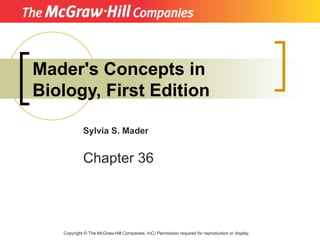
Chapter 36
- 1. Mader's Concepts in Biology, First Edition Sylvia S. Mader Chapter 36 Copyright © The McGraw-Hill Companies, InC) Permission required for reproduction or display.
- 2. Question 1 Which of the following is not true about overpopulation? A. it can be caused by a lack of predators B. it can increase levels of pollution C. it can damage water resources D. it can decrease disease transmission E. it can decrease food resources
- 3. Question 2 Ecology is best defined as the study of: A. populations B. the rate of population change C. how populations are restricted by environmental resistance D. population increases and decreases E. organisms as they interact with other organisms and their physical surrounding
- 4. Question 3 If you were studying the place where an organism lives, you would be studying its: A. biosphere B. habitat C. ecosystem D. community E. population
- 5. Question 4 All members of the same species that inhabit a particular area are termed a(n): A. ecosystem B. biosphere C. niche D. population E. community
- 6. Question 5 A number of populations of different species interacting with one another is called: A. competition B. a community C. an ecosystem D. predation E. symbiosis
- 7. Question 6 An ecosystem contains: A. only the biotic components of the environment B. only the abiotic components of the environment C. both the living and the abiotic components of the environment D. only the energy flow components of the environment E. only the food relationships found in an environment
- 8. Question 7 If you were writing a paper on the relatively thin layer on the earth's surface where life is possible you would be writing a paper on: A. the ecosystem B. the biosphere C. a biome D. a biopreserve E. lithosphere
- 9. Question 8 Your front yard represents a(n) __________ while the grasshoppers represent a(n) _____________. A. community; population B. population; ecosystem C. ecosystem; population D. population; community E. ecosystem; community
- 10. Question 9 A biologist is counting the number of individuals of a population per unit area. Based on this information you would conclude that he or she is trying to determine: A. population frequency B. population distribution C. population capacity D. population density E. population potential
- 11. Question 10 The pattern of dispersal of individuals across an area is referred to as: A. population frequency B. population distribution C. population capacity D. population density E. population potential
- 12. Question 11 The nonliving resources in the environment are referred to as abiotic. A. true B. false
- 13. Question 12 The aspects that determine which organisms live in the environment are called the: A. biotic factors B. density-dependent factors C. limiting factors D. density-independent factors E. life history factors
- 14. Question 13 Which of the following is not a type of distribution pattern found in organisms? A. clumped B. equilibrium C. uniform D. random E. All are patterns of distribution.
- 15. Question 14 Which of the following is not a factor in calculating a population’s annual growth rate? A. the number of individuals born B. immigration C. the number of individuals that die D. carrying capacity E. emigration
- 16. Question 15 If you were studying the maximum rate of natural increase of a population that can occur under ideal conditions you would be studying which of the following? A. population growth B. biotic potential C. environmental resistance D. carrying capacity E. steady state
- 17. Question 16 Which of the following is not a factor which affects biotic potential? A. age at which reproduction begins B. changes of survival until age of reproduction C. how many different mates each individual has D. how often each individual reproduces E. usual number of offspring per reproduction
- 18. Question 17 The term used to describe population members that are the same age and have the same chances of surviving is: A. a cohort B. biotic potential C. a metapopulation D. a population E. a family
- 19. Question 18 Which of the following describes a type II survivorship curve (drawn by plotting the number of individuals in a given population alive at the beginning of each interval)? A. most individuals die of old age B. many individuals die early in life C. individuals die at a constant rate throughout time D. most individuals die during their reproductive years E. most individuals die early in life and of old age
- 20. Question 19 A biologist is studying organisms which tend to exhibit a type I survivorship curve. Based on this information you would conclude that he or she is studying which type of organism? A. hydras B. oysters C. bacteria D. insects E. large mammals
- 21. Question 20 Age structure diagrams with a broad base suggest: A. the population will continue to grow for some time B. environmental resistance is not at work C. the biotic potential must be larger than usual D. the individuals must be larger than usual E. the population is shrinking
- 22. Answer Key – Chapter 36 A D 1. 1. E C 2. 2. B B 3. 3. D D 4. 4. B 5. B 5. C 6. C 6. B 7. A 7. A 8. C 8. D 9. E 9. B 10. A 10.
